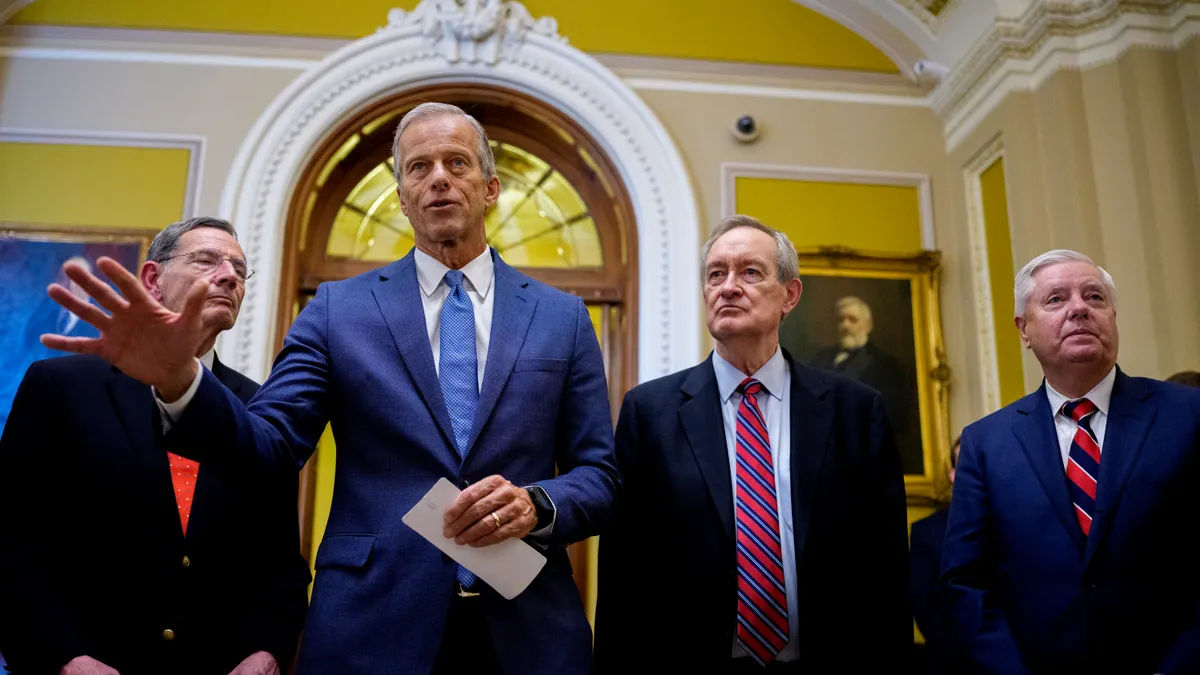As the U.S. offshore wind industry expands to meet state and federal goals, colleges in and around New Orleans are establishing wind energy programs geared at both young students and experienced workers from the oil and gas sector who are looking for new opportunities.
The offshore wind industry offers a significant economic opportunity for the region and those who live there, says Lacy McManus, executive director of future energy at economic development agency Greater New Orleans, or GNO. The state has lost “about 20,000 jobs over the last twenty or so years in the oil and gas sector,” she said. “So we have a number of folks who have the right skill sets, the right occupational profiles, who could be redeployed into the wind buildout.”
Program leaders at the University of New Orleans, or UNO, and Nunez Community College say they have partnered with companies like German multinational energy company RWE and Norwegian wind workforce education center Energy Innovation AS to develop a wind energy curriculum that adheres to global training standards and imparts the most in-demand skills.
“I see an opportunity for us to build an industry hub around some of our existing expertise, and universities will really play a key role in making that a reality,” said Shafin Khan, vice president of external affairs and innovation at UNO’s Research and Technology Foundation.
Khan was instrumental in the development of UNO’s Wind Scholars Program, which launched with an inaugural cohort of engineering students last fall. The program provides students with scholarships for courses specific to renewable energy, and paid internships with one of the participating companies — RWE, Entergy, Gulf Wind Technology, Edison Chouest Offshore or Keystone Engineering.
“Edison Chouest, a massive maritime oil and gas servicing player here in South Louisiana – they're very aggressively investing in the wind landscape, and have taken on one of those wind scholars,” said McManus. “The most important thing that our schools can be doing right now is having a hand-in-glove relationship with the different industrial players in their own backyards.”
The state of Louisiana has set a goal to deploy 5 GW of offshore wind by 2035, and an offshore wind lease off the state’s coast was purchased by RWE Offshore US Gulf last August for $5.6 million.
This was the first wind auction that the Bureau of Ocean Energy Management held in the Gulf of Mexico, and it wasn’t met with much enthusiasm – the price per acre was lower than it had been in previous auctions, and two tracts offshore Texas went unsold. But BOEM officials say they remain committed to offshore wind in the Gulf, and finalized four new wind energy areas there in October.
“The Gulf of Mexico is just a tremendously important region for offshore wind generally,” BOEM Director Liz Klein told Utility Dive in a December interview. “There's so much existing talent, infrastructure and equipment. The traditional offshore oil and gas industry is right now, as we speak, supporting the offshore wind industry. There's a lot of cross-pollination in the use of vessels and workforce and infrastructure.”
Companies in the region are already “exporting [their] know-how” when it comes to offshore operations, Khan said. Both he and McManus pointed to a May 2023 estimate from the Oceantic Network that Gulf Coast contractors have captured 26% of the U.S. offshore wind supply chain.
“The innovative turbines that we designed down here in the Gulf to address hurricanes and the unique conditions we have here – I see an opportunity to take those internationally to other markets, and help them install offshore wind in similar conditions,” Khan said.
At first, conversations about creating these programs were characterized by hesitancy about the novelty of offshore wind, McManus said. But GNO is now trying to “dispel the idea that we need to reinvent the wheel.”
“We're not creating space ranger academies,” she said. “So much of what's going to be needed is what we've always needed, and what we've had.”
Meeting a need
Demand for skilled workers is high in the U.S. wind energy industry. The Biden administration established a federal goal of deploying 30 GW of offshore wind by 2030, but employers are having difficulty finding experienced applicants, according to the National Renewable Energy Laboratory. To meet the 2030 goal, NREL found that full-time annual employment levels will need to reach “15,000 and 58,000 based on 25% and 100% domestic content scenarios, respectively.”
Jacqueline Richard, coastal studies and GIS technology program manager at Nunez Community College, said the school has developed a “three-tiered pathway toward wind,” but prioritized the career and technical certificate.
“That piece was the most important one to get started right away, because we recognize there are a lot of people in the offshore energy production realm that already have this training,” Richard said. “We wanted to offer an easy pathway for them to come in and get credit for prior learning, so they don't have to repeat material.”
Classes for the workforce development certification will start being offered this summer or fall, Richard said, while a program offering a technical diploma in wind energy will begin in the fall.
“We partnered with Energy Innovation AS out of Norway, and we're deploying their approved curriculum inside of our four-credit program,” Richard said. “And I received a grant from the [National Academies’] Gulf Research Program to support the first cohort of students through the program, so their tuition will be fully paid.”
A Global Wind Organization-certified associate's degree in wind energy technology will also launch at Nunez in the fall, and Richard said the school is working on building a “two-plus-two” relationship with UNO for students who want to transfer and earn a related bachelor’s degree.
“Prospective students that I've talked to, for the most part, are generally very excited — especially by the earning potential,” she said.
Students who complete the one-year program can expect to earn a base salary of around $60,000, Richard said, while Louisiana’s median household income in 2022 was around $58,000.
“I think the thing that excites me the most is this opportunity Louisiana currently has to shift our narrative,” she said. “We've been an energy leader since the early 1900s, we developed offshore energy production. And now we have this ability, and this knowledge, and all these skills to do the exact same thing but in the sustainable realm.”
However, Richard said, Louisiana’s long history with the oil and gas industry makes some prospective students a “tough sell” when it comes to educational opportunities in renewable energy.
“There's a lot of people who, understandably, are going to stay loyal to oil and gas because that's what their family has done for generations,” she said. “But when we meet with people who have a few reservations, but see the potential in how easy it would be to move over – usually the conversation heads off in a better direction.”






















